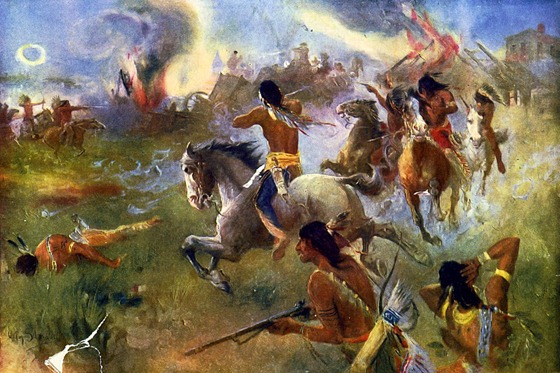On August 18, 1862, a Union recruiting party was ambushed by Sioux warriors not long after leaving New Ulm. Survivors rushed back to warn the town. The town was attacked the next day, with warriors firing from a bluff above. A second attack occurred on August 23, when New Ulm was completely encircled by the attacking Indians.
_____________________
Battle between Sioux Indians and settlers in August 1862.
The siege of New Ulm, Minn, painted by H. Aug. Schwabe about 1902. Library of Congress image.
____________________
Battles of New Ulm (from Wikipedia)
The Battles of New Ulm were two battles in the Dakota War of 1862 in August. The settlement of New Ulm, Minnesota had 900 settlers around the time and was the largest settlement near the Sioux reservation. After the Battle of Fort Ridgely, the town was seen as a tempting target for a Sioux attack. The topography of the town also presented an advantage for the Sioux, since the land rises some 200 feet out of the Minnesota River valley in two large steps, with wooded area to provide cover for an attack.
On August 18, 1862, a recruiting party for Civil War volunteers left New Ulm, but was ambushed in Milford Township. The survivors raced back to town and warned the settlers of an impending attack. The townspeople prepared for the attack by erecting barricades on the streets and packing the women and children into any available brick buildings. The first attack came on August 19, with about 100 Sioux warriors firing on the city from the bluff behind the town. A small number of civilians returned the fire as best as they could. Later in the day, a thunderstorm discouraged the Indians from continuing their attack, and there were no chiefs present to give orders. The first battle ended with six settlers killed and five wounded.
After the first attack, Charles Eugene Flandrau reached the city as part of a detachment from St. Peter and Le Sueur. Dr. Asa W. Daniels, Dr. Otis Ayer, and Dr. William Worrall Mayo (father of William James Mayo and Charles Horace Mayo) were also part of this group. Dr. Mayo and Dr. William R. McMahan of Mankato set up a hospital in the Dacotah House and Drs. Ayer and Daniels set up a hospital in a store across the street. This undoubtedly helped in the treatment of the wounded.
Flandrau’s forces were bolstered by about a hundred men from Mankato, two companies from Le Sueur, and militias from Brown County, Nicollet County, St. Peter, Lafayette, and New Ulm. In all, Flandrau had about three hundred citizen-soldiers under his command, but most were poorly armed. Meanwhile, more than a thousand settlers were barricaded on New Ulm’s main street. On Saturday, August 23, around 9:30 in the morning, the Sioux began their second attack on the city. The Sioux were superior in numbers, and were able to encircle the entire town. The defenders of New Ulm set many buildings on fire in an attempt to create an open space without cover. Captain William B. Dodd, second in command, was killed while leading soldiers beyond one of the barricades of the city. After nightfall, Flandrau ordered that the rest of the buildings outside of the barricades to be burned. In all, 190 structures within the city were destroyed. The next morning, August 24, the Indians reappeared, fired some harmless long-range shots, and then withdrew. Flandrau convened with his officers later that day and decided to evacuate the city, due to a shortage of ammunition and food and epidemics of disease. The following morning, August 25, 2000 people, including 153 wagons and a large number of refugees, left the city and headed to Mankato, about 30 miles to the east. The procession was escorted by about 150 troops and made it through to Mankato safely.



